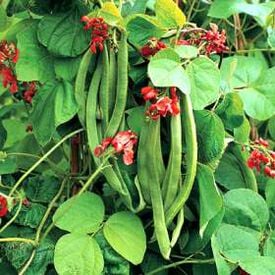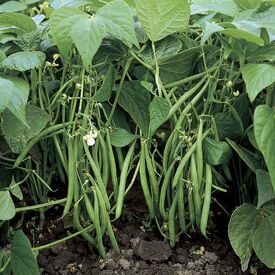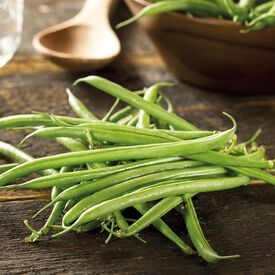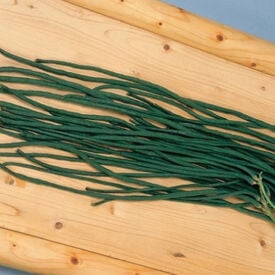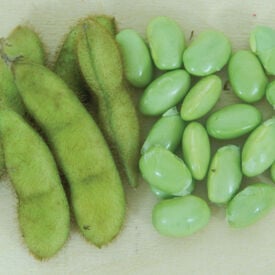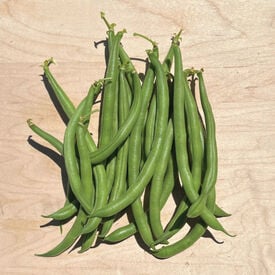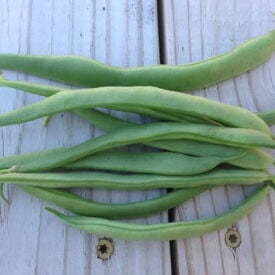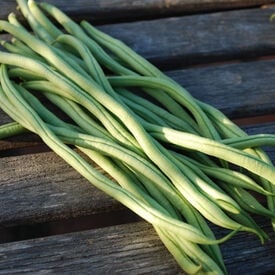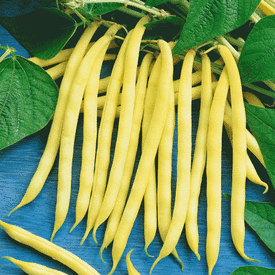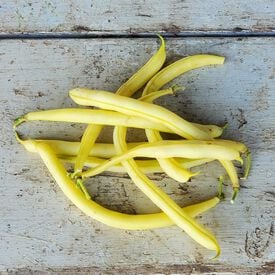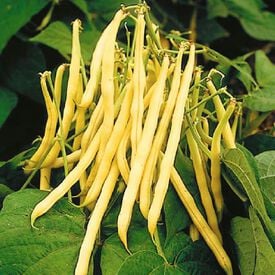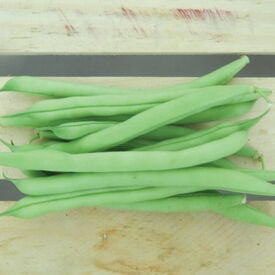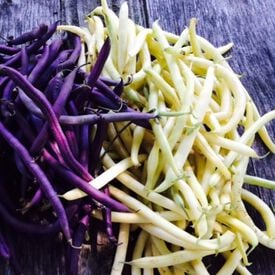Learn More
Scarlet Runner beans are a striking heirloom variety with a rich history that traces back to indigenous cultures in Central and South America. Introduced to Europe in the 17th century, these beans quickly gained popularity for both their ornamental beauty and culinary qualities. Characterized by their vigorous growth habit, Scarlet Runner plants can climb up to 10 feet or more, making them ideal for trellises or fences. The most notable feature of this variety is its vibrant scarlet flowers, which attract pollinators and add a stunning visual appeal to gardens. The pods are long and flat, typically green, maturing to a reddish hue, and are best harvested while still young and tender. Known for their rich, earthy flavor and creamy texture, Scarlet Runner beans are delicious in a variety of dishes, from stews to salads. Harvesting usually occurs in late summer to early fall, ensuring that the beans are picked before they dry out. With their ornamental charm, exceptional taste, and high productivity, Scarlet Runner beans remain a beloved choice for gardeners looking to combine beauty with culinary excellence.
Jameson Bean is a popular and versatile variety of bean known for its exceptional taste and rich history. These beans are classified as a bush bean, which means they grow in a compact, bushy fashion without the need for support structures. Jameson Beans are typically small to medium-sized, oval-shaped, and boast a creamy texture with a slightly nutty and earthy flavor profile. They are a beloved choice for both fresh consumption and canning due to their outstanding taste. With a historical background dating back decades, Jameson Beans have been a favorite among home gardeners and commercial growers alike. They have a relatively short maturity period, typically taking around 50 to 55 days to reach full maturity from the time of planting. The beans themselves are often a vibrant green color, making them visually appealing in a variety of dishes. In terms of growing characteristics, Jameson Beans exhibit good disease resistance, particularly against common bean diseases such as rust and bean common mosaic virus. The yield per row can vary depending on factors such as soil quality and care, but they tend to be productive plants, providing a substantial harvest. It is recommended to space the plants about 2-4 inches apart in rows that are approximately 18-24 inches apart. These beans thrive in well-drained soil and require full sun for optimal growth, making them a reliable choice for both novice and experienced gardeners.
Calypso bean seeds, also known as "Yin Yang" beans for their striking black-and-white pattern, produce compact bush plants that typically grow 15 to 20 inches tall. These heirloom beans mature in about 70 to 90 days and are cherished for their creamy texture and mild, earthy flavor, making them ideal for soups, stews, and salads. Calypso beans are easy to grow, thriving in full sun and well-drained soil, and they offer good drought tolerance. Their unique appearance and reliable performance make them a favorite among gardeners and heirloom seed enthusiasts alike.
A skinny filet bean with straight and smooth pods. Offers excellent flavor for home gardens and market growers. 5-6" pods that are resistant to anthracnose and bean mosaic virus.
The Orient Wonder bean is a white seeded yard-long bean with tender pods. This type of pole bean is sometimes called asparagus or yard-long bean. Popular in warm and humid areas, where plants are vigorously vining. Extra-long, slender pods are slow to form seeds, resulting in more tender beans that can be harvested over an extended period. Orient Wonder is popular for specialty and ethnic markets and superior to standard strains due to its ability to set in cooler climates.
Envy is an early harvesting edamame for shorter growing seasons. Envy produces erect bush bean plants that reach about two feet in height and produce pods each containing two to three green seeds. Edamame is a popular snack in Japan, served with beer. Due to its health benefits that other snacks do not provide, it is becoming popular in the United States.
Jade bush beans are long, uniform pods that reach 6-7" in length. With slender, deep green pods that burst with delicious flavor. A high yielding bean that doesn't mind stress and offers good disease resistance. Pale green seeds.
Greencrop beans are a classic heirloom variety renowned for their distinctive features and reliable performance. Originating in the early 20th century, this variety has been favored by gardeners for its robust growth and high productivity. Greencrop beans are characterized by their striking green color, smooth texture, and uniform shape. The plants are typically bush-type, reaching a height of about 18 to 24 inches, which makes them suitable for smaller garden spaces and easier to manage without extensive staking. The beans themselves are known for their crisp and tender texture, combined with a mildly sweet and fresh flavor that enhances a variety of dishes. Harvesting is best done when the pods are young and firm, usually in mid to late summer, to ensure optimal taste and texture. Greencrop beans are valued for their high yield and resistance to common diseases, making them a dependable choice for both home gardeners and market growers. With their appealing flavor, compact growth habit, and consistent performance, Greencrop beans remain a popular and practical selection for vegetable gardens.
The Fortex bean has a long pod that is slender and stringless. Fortex grow up to 11" long and produces round pods. An early maturing and very productive bean, that is very tender when picked early at 7". A great filet bean. Has the largest yields of any fresh bean. Walnut brown seeds.
The delicious buttery flavor of the Golden Wax Bush Bean make it a favorite among home gardeners! The stringless bright yellow pods are resistant common bean mosaic virus. The plant can produce pods 5-6 inches long. The Golden Wax beans are wonderful for canning, freezing and as a dry shell bean!
Python beans are a distinctive and versatile variety of pole beans, celebrated for their unique appearance and robust flavor. Named for their long, slender pods, which can reach up to 23" inches in length, Python beans offer an impressive visual appeal with their vibrant green color and smooth texture. The plants exhibit a vigorous climbing habit, often requiring sturdy trellises or poles for support as they grow to heights of 6 to 8 feet. Python beans are known for their crisp, tender pods and slightly sweet taste, making them an excellent choice for fresh eating, sautéing, or adding to various dishes. They are also prized for their resilience and adaptability, thriving in a range of soil types and weather conditions. With a maturity period of about 70 to 80 days, Python beans provide a reliable and attractive harvest, enhancing both the beauty and flavor of any vegetable garden.
Bountiful bean seeds produce one of the earliest and most reliable bush snap beans, known for their exceptional productivity and tender, stringless pods. Introduced in the late 19th century, this heirloom variety remains popular for its rich flavor, crisp texture, and consistent performance in a wide range of climates. The compact, bushy plants grow about 12 to 18 inches tall and do not require staking, making them perfect for small gardens or raised beds. Bountiful beans are easy to harvest and ideal for fresh eating, canning, or freezing. Their early maturity and dependable yields make them a favorite among home gardeners and market growers alike.
Cinnabar Mountain bean seeds produce striking, ornamental pole beans known for their vivid scarlet flowers and long, slender pods. This variety is not only visually appealing but also productive, climbing vigorously and yielding beans that can be eaten young as snap beans or left to mature for dry beans. Named after the cinnabar-red hues of its blooms, it attracts pollinators like hummingbirds and bees, making it a beautiful and beneficial addition to gardens. The plants thrive in warm weather with full sun and well-drained soil, and they require sturdy trellising due to their vigorous vining habit. Cinnabar Mountain beans combine aesthetic charm with culinary value, making them a favorite for both ornamental and edible landscapes.
Beautiful bright yellow beans that grow on 5-6" pods. They grow straight and on large, upright plants. A flavorful bean with high disease resistance.
The Pencil Pod Black Wax bean is a highly productive and long standing bush bean. Also known as 'Eastern Black Wax', these beans are bushy, vigorous, and resistant to rust and mosaic virus. The pods are golden color and grow to 5-7" long. A great all-purpose type, that is great fresh, canned, or frozen. As the name hints, the seeds are black.
Dapple Grey bean seeds grow into compact bush plants reaching about 18 to 24 inches in height and typically mature in 85 to 95 days. This heirloom dry bean variety is known for its eye-catching gray seeds mottled with darker streaks, giving it a distinctive “dappled” appearance. Dapple Grey beans have a rich, hearty flavor and a firm texture, making them a popular choice for soups, stews, and chili. Easy to grow and well-adapted to a variety of climates, these beans thrive in full sun and well-drained soil, offering reliable yields and excellent storage quality.
Provider beans are a popular bush bean variety that has garnered attention for its reliable performance and ease of cultivation. Developed in the United States, Provider beans have a rich history dating back to the mid-20th century, when they were bred for both home gardens and commercial production. These beans are characterized by their compact growth habit, typically reaching about 18 to 24 inches in height, which makes them perfect for small spaces and easy to manage without staking. The pods are smooth and a vibrant green color, generally growing to about 5 to 6 inches long. Known for their excellent flavor and crisp texture, Provider beans are ideal for fresh eating, canning, or freezing. Harvesting is best done when the pods are young and firm, usually in mid to late summer, ensuring the best taste and quality. The plants are vigorous and produce high yields, demonstrating good resistance to common diseases. With their dependable growth, delightful flavor, and adaptability, Provider beans remain a favorite choice for both novice and experienced gardeners.
The Mardi Gras Blend is almost too pretty to eat! These fun bright yellow and purple semi flat bean pods are a favorite among home chefs. The Mardi Gras Blend sets a heavy crop of delicious nutty beans. These organic heirlooms are a fun way to get beneficial nutrients.
